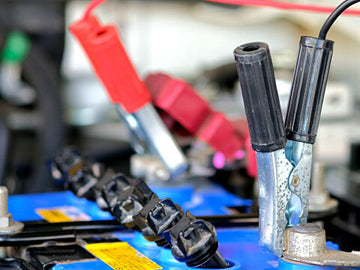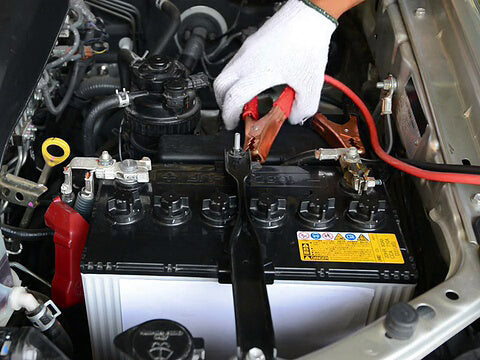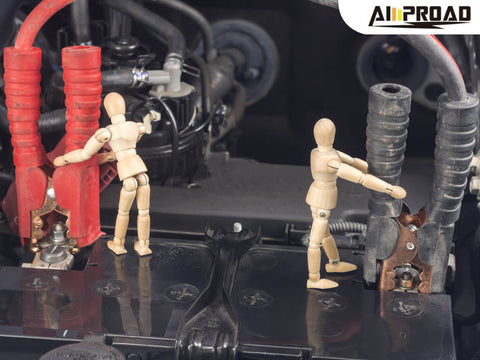Will Leaving a Portable Jump Starter Connected Slowly Charge the Car Battery?
Apr 29, 2024

Dead car battery? Jump starter to the rescue! But can it slowly recharge your battery? Explore the risks & benefits of leaving a jump starter connected. Find safe & effective charging alternatives for a healthy car battery.
A dead car battery can leave you stranded, but a portable jump starter can get you going again in a pinch. But what if your battery isn't completely dead? Can you leave the jump starter connected to slowly recharge it? Hold on! While a jump starter is a lifesaver for jump-starting a car, it's not designed for long-term charging. We'll explore the potential risks and benefits of this approach, and discuss safe and effective alternatives to keep your car battery healthy and your travels worry-free.
What Are Jump Starters?
A dead car battery can turn a smooth journey into a frustrating halt. But fear not! Portable jump starters have become lifesavers for many drivers, offering a quick and convenient solution to get your car back up and running. However, before you rely on a battery booster in a pinch, it's important to understand how they work and their limitations. This article will be your guide, diving deep into the world of jump starters.
What is the primary function of a portable jump starter?
Imagine a portable battery specifically designed to give your car battery a much-needed jolt of energy. That's exactly what a jump starter is! Unlike a car battery, which provides sustained power to the electrical system while the engine is running, a jump starter packs a powerful punch specifically for starting the engine. Think of it like a temporary jumpstart your car needs to get its own systems running.
How does a jump starter provide a quick burst of power to start a car battery?
So, how to boost a car, how does this jolt of energy happen? When your car battery is depleted, it can't provide enough power to crank the engine. A jump starter comes to the rescue by delivering a surge of high current. This surge bypasses the weak car battery and provides the necessary power directly to the starter motor. With this extra boost, your car's engine cranks and hopefully roars back to life, allowing you to get back on the road.
In essence, a jump starter acts like a temporary power source to get your car's engine going, not a replacement for a healthy car battery. In the following sections, we'll explore the dos and don'ts of jump starters, safe practices, and alternative solutions to keep your car's battery in top shape.
Will Leaving a Portable Jump Starter Connected Slowly Charge the Car Battery?

While a jump starter can be your knight in shining armor when your car battery is down, it's not meant for extended connections. Let's delve into the potential risks of leaving a jump starter hooked up for a long time:
Can leaving a jump starter connected for an extended period slowly charge a car battery?
Technically, yes, a jump starter left connected might provide a very slow trickle charge to your car battery. However, this is highly inefficient and impractical for several reasons:
- Limited Capacity: Jump starters are designed for a quick burst of power, not sustained charging. Their internal batteries wouldn't last long trying to recharge a car battery.
- Safety Concerns: Leaving electronics connected for extended periods can pose safety risks like overheating. Both the jump starter and car battery could be at risk.
- Ineffective Charging: Even if it did work, the slow charge rate wouldn't be enough to fully recharge a depleted car battery in a reasonable timeframe.
Could a continuous connection from a jump starter harm the car battery or the jump starter itself?
- A continuous connection can be detrimental to both your car battery and the jump starter:
- Car Battery Damage: Overcharging a car battery can damage its internal components and shorten its lifespan. While a jump starter wouldn't provide a massive overcharge, it's still not ideal for long periods.
- Jump Starter Woes: Leaving the jump starter connected can drain its own internal battery and potentially damage its internal circuitry if not designed for such use.
While the idea of a slow charge might seem appealing, it's best to avoid leaving a jump starter connected to your car battery. It's a risky proposition that offers minimal benefits and potential drawbacks. In the next section, we'll explore safer and more effective ways to recharge your car battery.
Alternative Charging Strategies
When a jump starter isn't ideal for long-term charging, exploring alternative methods becomes crucial for recharging a car battery.
If a jump starter isn't suitable for long-term charging, what are alternative methods to recharge a car battery? While jump starters are excellent for emergency situations, they're not designed for prolonged charging. In such cases, utilizing a standard outlet with a car battery charger is a viable option. Car battery chargers are specifically designed to safely recharge car batteries over an extended period. By connecting the charger to a standard outlet, you can replenish the battery's charge gradually and effectively.
Additionally, there are alternative portable charging solutions available that offer versatility and convenience. For instance, the AMPROAD portable jump starter provides a multifunctional solution for both jump-starting vehicles and charging various devices. With its compact and lightweight design, the AMPROAD jump starter is easy to carry and store, making it an excellent option for on-the-go charging needs. Featuring advanced safety features and a high-capacity battery, the AMPROAD jump starter offers reliable performance and peace of mind during emergencies or remote charging situations.
By considering these alternative charging strategies and utilizing suitable devices like car battery chargers or portable battery booster, drivers can effectively recharge their car batteries and ensure reliable performance on the road. Whether for emergency situations or routine maintenance, having the right charging solution at hand is essential for maintaining optimal battery health and vehicle functionality.
Safety Considerations

Leaving a jump starter connected to a car battery for an extended period can pose safety risks that need to be addressed.
While jump starters are designed for short-term use in emergency situations, prolonged connection can lead to overcharging, which may damage the battery or cause overheating. Overcharging occurs when the jump starter continues to supply power to the battery even after it's fully charged, potentially resulting in electrolyte leakage, battery swelling, or even explosion in extreme cases.
Continuous use of a battery booster pack can also drain its internal battery, reducing its effectiveness when needed in an emergency. This can leave you stranded without a reliable means of jump-starting your vehicle in critical situations.
To mitigate safety hazards, it's crucial to follow manufacturer guidelines and disconnect the jump starter once the vehicle starts. Additionally, avoid leaving the jump starter connected for more than the recommended duration specified in the user manual.
For long-term battery maintenance, consider alternative charging methods such as using a car battery charger. These devices are specifically designed for recharging car batteries over an extended period without posing the same risks as jump starters. Alternatively, seek professional assistance if you need to leave your vehicle unattended for an extended period and require battery maintenance.
By understanding the safety risks associated with leaving a jump starter connected to a car battery and taking appropriate precautions, you can ensure the safety of yourself and your vehicle while effectively addressing battery-related issues.
Best Practices and Considerations
Considering the safety risks and limitations associated with leaving a jump starter connected to charge a car battery slowly, it's generally not advisable to rely on this method for long-term charging.
Based on the above points, is it advisable to leave a jump starter connected to slowly charge a car battery?
No, it is not advisable to leave a jump starter connected to slowly charge a car battery for an extended period due to safety risks such as overcharging and potential damage to the battery or the jump starter itself. Jump starters are designed for short-term emergency use, and using them for prolonged charging can compromise their effectiveness and pose safety hazards.
What are the best practices for using a jump starter and ensuring a healthy car battery?
When using a jump starter, knowing how to give a car boost properly is essential. Follow these best practices to ensure a healthy car battery and safe operation:
- Use the jump starter only for its intended purpose: emergency jump-starting.
- Disconnect the jump starter as soon as the vehicle starts to avoid overcharging.
- Follow manufacturer guidelines and recommendations for usage duration.
- Regularly inspect the jump starter for any signs of damage or wear and tear.
- Store the jump starter in a cool, dry place when not in use and keep it charged to maintain its readiness.
- Consider alternative charging methods, such as using a car battery charger, for long-term battery maintenance.
By adhering to these best practices and understanding the limitations of jump starters, you can effectively maintain a healthy car battery and ensure safe jump-starting when needed.


